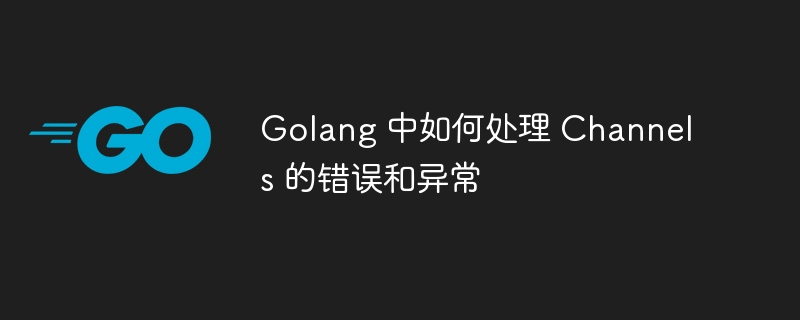Home >Backend Development >Golang >How to handle Channels errors and exceptions in Golang
How to handle Channels errors and exceptions in Golang
- WBOYWBOYWBOYWBOYWBOYWBOYWBOYWBOYWBOYWBOYWBOYWBOYWBOriginal
- 2023-08-07 16:15:221107browse

How to handle Channels errors and exceptions in Golang
Introduction:
In Go programming, goroutine and channel are two important concepts. Goroutine is a lightweight thread, and channel is used for communication between goroutines. During the use of channels, some errors and exceptions may occur. This article will introduce how to handle Channels errors and exceptions in Golang, and provide corresponding code examples.
1. The basic principles of Channels in Golang
In Golang, channel is a pipeline for communication between goroutines. It uses a queue (FIFO) internally for data transmission. Channel provides send and receive operations, which are used to send data to and receive data from the channel respectively.
- Create channel:
In Golang, we can use themakekeyword to create a channel. The sample code is as follows:
ch := make(chan int)
- Send data to the channel:
Use the<-operator to send data to the channel. The sample code is as follows:
ch <- 1
- Receive data from channel:
Use<-operator to receive data from channel. The sample code is as follows:
data := <- ch
2. Error handling skills
- Sending data to a closed channel:
In Golang, when data is sent again to a closed channel, a panic error will occur. We can handle errors by using the select statement before sending the operation. The sample code is as follows:
ch := make(chan int)
close(ch)
select {
case ch <- 1:
fmt.Println("数据发送成功")
default:
fmt.Println("channel 已关闭,无法发送数据")
}In the above code, when the channel has been closed, ch <- 1 The send operation will be captured by the default branch in the select statement to implement error handling.
- Receive data from a closed channel:
In Golang, when data is received again from a closed channel, a zero value of the channel element type will be returned and panic will not be triggered. mistake. We can determine whether the channel has been closed by judging the zero value returned after the receive operation. The sample code is as follows:
ch := make(chan int)
close(ch)
for {
data, ok := <-ch
if !ok {
fmt.Println("channel 已关闭")
break
}
fmt.Println("接收到数据:", data)
}In the above code, when the channel has been closed, data , ok := The receive operation of <-ch returns a zero value of type int, and the value of ok is false. We can handle the channel closing situation by judging the value of ok.
3. Exception handling skills
- Use buffered channels:
In Golang, the default channel is unbuffered, that is, there must be a corresponding channel before receiving data Send operation. Buffered channels can cache a certain number of elements before sending operations to avoid blocking and waiting. We can use the select statement and the buffered channel to implement exception handling. The sample code is as follows:
ch := make(chan int, 1)
select {
case ch <- 1:
fmt.Println("数据发送成功")
default:
fmt.Println("channel 已满,无法发送数据")
}In the above code, the buffer size of the channel is set to 1, which means that it can only be cached. an element. When the channel buffer is full, the send operation of ch <- 1 will be captured by the default branch in the select statement to implement exception handling.
- Use channel with timeout:
In Golang, we can use thetime.Tickfunction to create a timer, combining the select statement and the channel with timeout to complete the pairing Operation timeout processing, the sample code is as follows:
ch := make(chan int)
timeout := make(chan bool)
go func() {
time.Sleep(3 * time.Second) // 模拟耗时操作
timeout <- true
}()
select {
case data := <-ch:
fmt.Println("接收到数据:", data)
case <-timeout:
fmt.Println("操作超时")
}In the above code, a time-consuming operation is simulated through the time.Sleep function, and after the operation is completed, timeout channel sends a true value. If no data from ch is received within 3 seconds, the timeout branch will be triggered to implement timeout processing of the operation.
Summary:
In Golang, correctly handling Channels errors and exceptions is one of the keys to writing robust and efficient code. Through reasonable error handling and exception handling techniques, we can ensure the reliability and stability of the program. I hope that the methods introduced in this article can be helpful to everyone who encounters Channels-related problems in Golang development.
The above is the detailed content of How to handle Channels errors and exceptions in Golang. For more information, please follow other related articles on the PHP Chinese website!
Related articles
See more- What types of exceptions are there in Python? Introduction to python exception handling
- How to deal with errors in JavaScript? Error handling methods in JavaScript
- An article explaining in detail how Vue3 handles global exceptions
- How to handle errors in golang
- Goroutines and Channels in Golang implement concurrent communication

